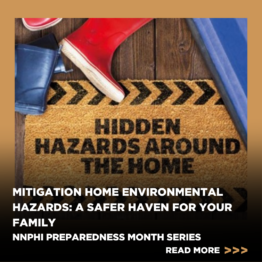National Preparedness Month Vol. 4: Mitigation Home Environmental Hazards: A Safer Haven for Your Family
- By: National Network of Public Health Institutes and Jennifer Ventura
- Date
Creating a safe and secure home environment goes beyond just aesthetics and comfort, this involves identifying and mitigating potential environmental hazards. Whether you’re a homeowner or a renter, taking proactive measures to eliminate or reduce these hazards can significantly enhance the safety and well-being of your family. Learn about how the Federal Environmental Management Agency (FEMA) promotes awareness to reduce risks in your home. This September, as we observe Environmental Preparedness Month, let’s explore the importance of recognizing and addressing home environmental hazards.
Identifying Common Environmental Hazards
- Indoor Air Pollutants: Poor indoor air quality can lead to various health issues. Identify and eliminate sources of pollutants such as cigarette smoke, mold, volatile organic compounds (VOCs), and dust mites. Ensure proper ventilation to maintain fresh air circulation.
- Water Contamination: Contaminated water can pose a serious health risk. Regularly test your water supply for contaminants and address any issues promptly. If you are unsure of the cleanliness of the water you are consuming, use water filters if necessary to ensure clean drinking water.
- Lead and Asbestos: If your home was built before 1978, it may contain lead-based paint. Additionally, older homes may have asbestos-containing materials. It is important to be sure to hire professionals to assess and safely remove these hazardous substances.
- Radon Gas: Radon is a colorless, odorless gas that can seep into homes from the ground. It’s a known carcinogen. Test your home for radon and take steps to eliminate its presence.
Mitigation Strategies for a Safer Home
- Regular Cleaning: Regular cleaning can significantly reduce indoor pollutants. Vacuum and dust regularly and use high-efficiency particulate air (HEPA) filters in your vacuum and air purifiers.
- Proper Ventilation: Ensure your home is well-ventilated, especially in areas prone to moisture, like bathrooms and kitchens. Use exhaust fans to reduce humidity and prevent mold growth.
- Water Testing: Regularly test your water for contaminants, especially if you have a private well. Address any issues identified through testing promptly.
- Lead and Asbestos Inspection: If you suspect lead-based paint or asbestos-containing materials, hire certified professionals to conduct inspections and safely remove these hazards.
- Radon Mitigation: If your home tests positive for radon, contact professionals to install a radon mitigation system that reduces the gas’s concentration.
Promoting a Healthier Living Environment
Mitigating home environmental hazards isn’t just about safety; it’s about creating a healthier living environment for you and your family. By taking these steps, you’re ensuring that your home remains a sanctuary where everyone can thrive both physically and mentally.
This Environmental Preparedness Month, take the time to assess your home for potential hazards and address them proactively. Your efforts will contribute to a safer and healthier living space for years to come. Remember, a well-prepared home is a strong foundation for a resilient future.
About the Author:
Jennifer Ventura is a Program Assistant on the Climate, Crisis, and Preparedness Portfolio at the National Network of Public Health Institutes (NNPHI). She received her bachelor’s degree in Public Health from George Mason University in 2021. With an interest in Public Health and working on a focus on environmental health, my passion lies in understanding the relationship between human well-being and the environment. Through academic pursuits and current work experiences, I’ve become interested in the critical role of promoting climate change awareness. Recognizing that a healthy environment is crucial for community health, I’m dedicated to advocating for policies and practices that foster sustainability and safeguard the planet for current and future generations.


 Subscribe To Our Communications
Subscribe To Our Communications